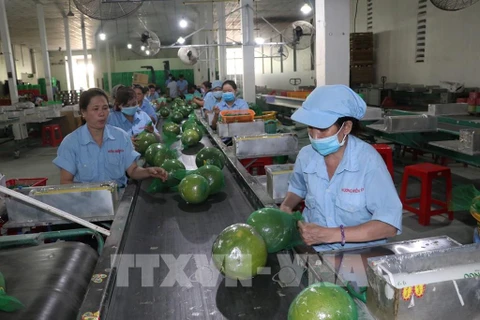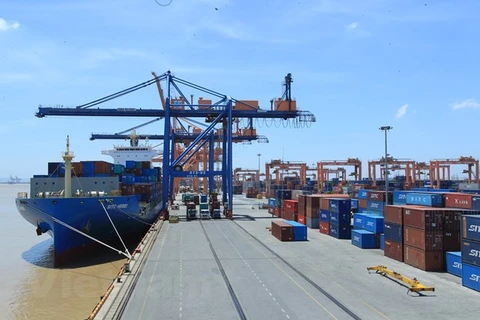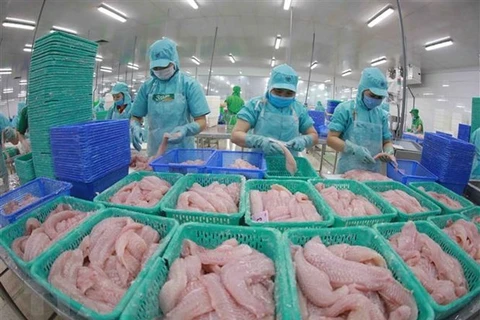 Photo: Customs clearance of goods at the Tan Cang Sai Gon (Saigon New Port) Corporation (SNP) (Photo: VNA)
Photo: Customs clearance of goods at the Tan Cang Sai Gon (Saigon New Port) Corporation (SNP) (Photo: VNA) Hanoi (VNA) – Vietnam has been forecast to have 37 groups of commodities posting an export value of over 1 billion USD each in 2021, an increase of four groups compared to 2020, despite the complicated developments of the COVID-19 pandemic.
Even with the impacts of COVID-19, Vietnam's exports in 2021 were once again a bright spot in the economic picture of the country.
The list of billion-USD export items has been expanded, contributing to reducing the pressure of trade deficit and increasing the position of the "Made in Vietnam" brand in the international market.
The results are attributed to the drastic and flexible direction and management of the Government, ministries, sectors and localities, and the great efforts and determination of the business community.
According to a report by the Ministry of Industry and Trade (MoIT), Vietnam’s export-import turnover is likely to hit an estimated 660.1 billion USD in 2021, up 21 percent compared to the previous year.
Export value is estimated at 331.1 billion USD, while imports may reach 329 billion USD, up 17.2 percent and 25.2 percent year-on-year, respectively.
The export turnover for the whole year is predicted to maintain a two-digit growth (10-20 percent), much higher than the 4-5 percent target set by the industry and trade sector at the beginning of 2021.
This is an impressive result, despite the negative impacts of the COVID-19 pandemic, particularly the fourth outbreak that saw the Delta variant sweeping through industrial production enterprises, export hubs and key economic zones.
The trade balance in 2021 was balanced, enjoying a trade surplus of 2.1 billion USD, up 0.64 percent year-on-year.
According to Tran Thanh Hai, deputy director of the MoIT's Import-Export Department, the processing industry continues to drive the national economy, contributing 89 percent to the total export turnover.
As well as shipping complete products abroad, Vietnamese companies also exported components, a trend that recorded strong growth in the year, Hai said.
Vietnam also recorded strong export growth in Japan and the Republic of Korea, on top of traditional export markets like China, the US, and EU, experts said.
This shows that businesses are taking advantage of free trade agreements (FTAs) to promote their export, they added.
Grabbing new opportunities
According to the MoIT, the Government has exerted efforts to expand export markets through bilateral and multilateral trade negotiations, contributing to removing barriers for Vietnamese exporters.
Vietnam's exports have made inroads into markets that are considered the most fastidious in the world, where strict regulations and high technical standards are needed for imported goods, especially agricultural and aquatic products - a group greatly affected by the pandemic.
Economist Nguyen Minh Phong said Vietnamese enterprises have many opportunities to expand exports based on fully tapping new-generation FTAs, such as the Comprehensive and Progressive Agreement for Trans-Pacific Partnership (CPTPP), the EU-Vietnam Free Trade Agreement (EVFTA) and the Regional Comprehensive Economic Partnership (RCEP) Agreement.
Experts underlined the important contribution of e-commerce and digital transformation to export growth.
Promoting e-commerce and displaying brands and products via international and regional online exhibitions are effective solutions that have helped enterprises expand their exports in the context of the COVID-19 pandemic, they said.
Through e-commerce platforms, businesses have brought Vietnamese goods into the distribution system of many countries, experts noted.
Regarding import, Vietnam can actively choose to import materials and machinery of higher quality for manufacturing and production industries, thus producing products with higher competitiveness.
Experts, however, pointed out some shortcomings that need to be resolved.
According to commercial expert Associate Professor Dr Pham Sy Thang, the FDI sector accounts for more than 70 percent of the country’s export revenue, and will likely increase in the future. Meanwhile, the contribution of enterprises with 100 percent private-owned capital remains modest.
Thang emphasised the role played by State management agencies in creating motivation for the domestic business community and taking solutions to connect FDI enterprises with domestic ones.
Hai said enterprises need to pay attention to risk management and prevention, especially supply and supply chain disruption.
Trade remedies from import markets can also cause certain difficulties for export businesses, so they should have preparations to respond, Hai said./.
























